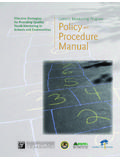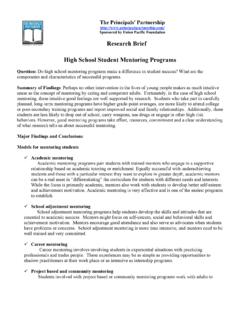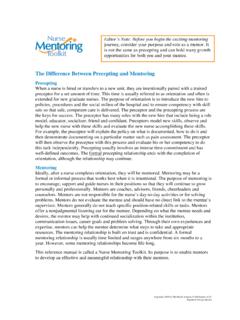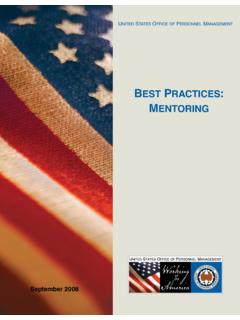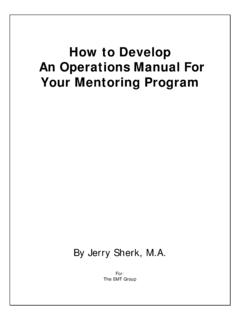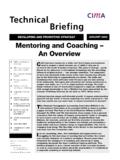Transcription of S L N G Mentoring Millennials - Harvard Business …
1 POTLIGHT ON L EADERSHIP: T HE N EXT G ENERATION Mentoring Millennials by Jeanne C. Meister and Karie Willyerd Delivering the feedback Gen Y craves is easier than you think. Reprint R1005DS POTLIGHT ON L EADERSHIP: T HE N EXT G ENERATION Mentoring Millennials by Jeanne C. Meister and Karie Willyerd Harvard Business review may 2010page 1 COPYRIGHT 2010 Harvard Business SCHOOL PUBLISHING CORPORATION. ALL RIGHTS RESERVED. Delivering the feedback Gen Y craves is easier than you think. The makeup of the global workforce is under-going a seismic shift: In four years Millenni-als the people born between 1977 and 1997 will account for nearly half the employees inthe world. In some companies, they alreadyconstitute a shift may sound daunting to the manag-ers charged with coaching these young workers,who have a reputation for being attentionsponges. However, our research into the varyingexpectations and needs of employees acrossfour generations has given us a more nuancedview of Millennials and uncovered several re-source efficient ways to mentor polled 2,200 professionals across a widerange of industries, asking about their values,their behavior at work, and what they wantedfrom their employers.
2 The Millennials , we saw,did want a constant stream of feedback andwere in a hurry for success, but their expecta-tions were not as outsized as many s good news for organizations wonderingjust who will mentor this rising Boomers are retiring, and Gen X may notbe large enough to shoulder the responsibilityalone. In the , for instance, the 88 millionMillennials vastly outnumber Gen Xers, whoare just 50 million view work as a key part of life,not a separate activity that needs to be bal-anced by it. For that reason, they place astrong emphasis on finding work that s person-ally fulfilling. They want work to afford themthe opportunity to make new friends, learnnew skills, and connect to a larger sense of purpose is a key factor in theirjob satisfaction; according to our research,they re the most socially conscious generationsince the 1960s.
3 Oh, they want total fulfillment? managersmay be thinking. Is that all? Yes, Millennialshave high expectations of their employers but they also set high standards for ve been working on their r sum s practi-cally since they were toddlers, because thereare so many of them and so few (relativelyspeaking) spots at top schools and top compa-nies. They re used to overachieving academi- Mentoring Millennials S POTLIGHT ON L EADERSHIP : T HE N EXT G ENERATION Harvard Business review may 2010page 2 cally and to making strong personal commit-ments to community service. Keep themengaged, and they will be happy to over-achieve for , they want a road map to success,and they expect their companies to provide you re not careful, grooming them for lead-ership roles could drain your managers en-ergy. To help you, we ve identified three kindsof Mentoring that will prepare Millennials forsuccess without requiring your experiencedstaffers to spend all their time coaching.
4 Whilethese approaches will work with employees inother generations, too, they re especially effec-tive with Millennials , because they suit this co-hort s mobile, collaborative lifestyle and needfor immediacy. Reverse Mentoring This approach shifts the responsibility for or-ganizing Mentoring to line employees, wholearn from senior executives by mentoringthem. A millennial is matched to an executiveand assigned to teach him or her how to, say,use social media to connect with s an effective way to give junior employees awindow into the higher levels of the organiza-tion, so that when the mentees retire, theyounger generation has a better understand-ing of the Burson-Marsteller, a PR and communica-tions firm with offices in 85 countries, a pilotprogram of reverse Mentoring is bridging expe-riential divides. The company conducted train-ing for both millennial mentors and theirolder mentees, establishing ground rulesaround confidentiality.
5 It s difficult not to slipinto our traditional roles, says Michele Chase,the managing director of worldwide human re-sources. But this arrangement is building rela-tionships. The mentors are getting access tomore senior people, and they get to go behindthe scenes, so to speak, to see how leadersthink and offer insights. Inevitably, there are times when the oldermentees give feedback or advice to their youngassociates, so in effect, the coaching becomesmutual. The added benefit to the younger work-ers is a potentially accelerated career track, asthe Mentoring arrangement raises their profileamong senior executives of the firm. And the ex-ecutive mentees have the opportunity to gainunderstanding of a segment of their workforcethey might not otherwise get to know. Group Mentoring Group Mentoring is a less-resource-intensivebut still effective way of giving Millennials thefeedback they crave. It can be led by a moresenior manager or can be peer-to-peer, but inboth cases, the company sets up a technologyplatform that allows employees to define men-toring in their own AT&T Mentoring takes place in self-organizing, topic-based groups, which AT&Tcalls leadership circles.
6 The self-organizing ap-proach allows them to reach far more employ-ees than programs run by HR. Using an onlineplatform, one mentor can work with severalmentees at a time sometimes in different loca-tions on skills like generating sales leads orleading teams. The circles take advantage ofplatform features such as community forums,document-sharing spaces, group polling, and cal-endars that announce events and mentor avail-ability. Since the supporting software has somebuilt-in social-networking capability, menteesare able to connect to others with very littlehands-on assistance from HR; peer-to-peer men-toring often starts to take place within a circle asit matures. Managers frequently share mentor-ing responsibilities within a circle for instance,three executives might work together to advise agroup of nine employees. Face-to-face meetings,conference calls, and webcasts supplement theonline , the British telecommunications firm, offersanother example of group Mentoring : a peer-to-peer learning program it calls Dare2share.
7 Wefound 78% of our employees preferred to learnfrom their peers, but little money or attentionwas focused on this, explains Peter Butler, thehead of learning at is a social collaboration platformthat allows employees to pass on their knowl-edge and insights to their colleagues throughshort (five- and 10-minute) audio and videopodcasts, RSS feeds, and discussion threads, aswell as through traditional training employees can view content on Dare2shareand rate each learning module according to itsrelevance and quality. If they want to learnmore about the topic covered by a module,they can connect with the person who posted itand ask for more just out of its four-month proof-of-concept stage, the program is already produc-ing results: New hires now get up to speedmore quickly, and training costs have fallen. Jeanne C. Meister is a cofounder of Future Workplace.
8 She is the author of two books on corporate universities and the coauthor with Karie Willyerd of The 2020 Workplace: How Innovative Compa-nies Attract, Develop, and Keep Tomor-row s Employees Today (HarperBusiness, 2010). Karie Willyerd is a cofounder of Future Workplace. She was formerly the chief learning officer of Sun Micro-systems and head of learning and de-velopment at Heinz. Mentoring Millennials S POTLIGHT ON L EADERSHIP : T HE N EXT G ENERATION Harvard Business review may 2010page 3 Among some executives, Dare2share has be-come the communication tool of choice. Forinstance, the CEO of one Business unit nowuses it to report quarterly results via short vid-eos, which give his message broader exposure. Anonymous Mentoring This method uses psychological testing and abackground review to match mentees withtrained mentors outside the organization. Ex-changes are conducted entirely online, andboth the mentee and the mentor, who is usu-ally a professional coach or seasoned execu-tive, remain anonymous.
9 The engagement,generally paid for by the mentee s company,lasts six to 12 months. In a typical exchange,the mentee might send a message such as this:Hey Mentor,Tomorrow afternoon I m presenting our Q4forecast to the board of directors. I am deliver-ing some bad news and am quite nervous. Infact, I m VERY nervous! Can you help?The mentor might respond:Hey Mentee,I got your message, and you should knowthat I have done literally hundreds of presenta-tions of good news and I have bad news, I like to present abenefit/cost analysis of the news. I have foundthat quantifying it takes away the subjectivityof the message (and the messenger) and al-lows all parties to focus on what they can do tofix there with a mitigation plan, , somepotential solutions to your bad news. I havefound that boards like to make decisions, sogiving them a set of options to choose from isgreat!Finally, rehearse your presentation withsomeone.
10 Let whoever is your audience bevery critical of you. That way the real experi-ence will be much luck, and let me know how it of the mentors we spoke with is BobWall, 64, of Connecticut. Having spent 29 yearsas a consultant and executive coach, he at firstcouldn t imagine that anonymous mentoringcould work. But once he was matched with amentee, he was amazed at how well they werepaired. I felt like I had a twin out there some-where, he told us. It turned out to be a highlyintimate relationship while remaining com-pletely anonymous. In fact, when the sixmonths was up, it was like losing a dear friend. We heard from both mentors and menteesthat the anonymity was an unexpected Sherriff, 33, the vice president of cre-ative services at Decision Toolbox, is just sucha mentee. My original thought was that itwould be odd, and it was awkward initially, she says.



